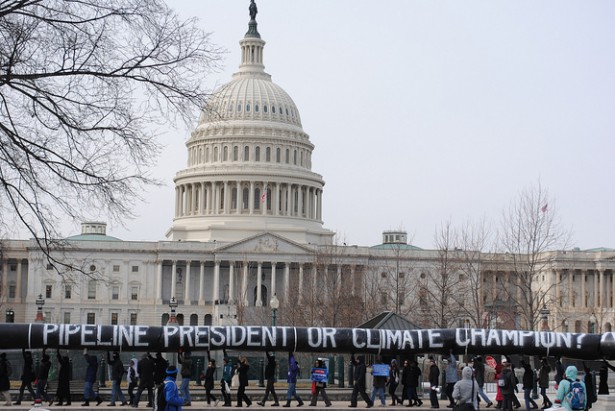
For just the third time in his presidency, Barack Obama used his executive power to veto Senate Bill 1, the Keystone Pipeline Approval Act. The legislation would have rushed approval of the controversial TransCanada pipeline, slated to carry 800,000 barrels of oil from Alberta, Canada through six U.S. states to the Gulf of Mexico.
In a two-paragraph letter to the Senate, Obama explained that “because this act of Congress conflicts with established executive branch procedures and cuts short thorough consideration of issues that could bear on our national interest — including our security, safety and environment — it has earned my veto.”
The decision is a win for pipeline opponents, but a cautious one.
“This veto is conclusive proof that activism works,” 350.org Executive Director May Boeve said in a statement. “After four years of rallies, marches, sit-ins and civil disobedience, we’re thrilled to see President Obama take an important first step by vetoing this love letter to Big Oil.”
The fight over Keystone has galvanized a newer and more militant environmental movement, which over the last several years has come to embrace more confrontational tactics around not just Keystone, but other pipelines, hydraulic natural gas fracturing and university investments in fossil fuels.
Taking on Keystone also led to greater collaboration between environmental organizations. The Indigenous Environmental Network, Bold Nebraska and other groups on the frontlines of Keystone’s potential impacts have been some of its most vocal opponents, partnerning with national organizations such as 350.org and Oil Change International to mobilize against it.
These shifts have not gone unnoticed by Republicans. House Majority Leader John Boehner of Ohio condemned the decision and Obama for being too close to “environmental extremists.” For their part, the GOP has pledged again to make passing Keystone a priority. A statement from Republicans issued yesterday criticized the White House, saying “the American people … overwhelmingly support this vital jobs and infrastructure project.”
Actual polling on Keystone tells a different story. An NBC News/Wall Street Journal survey from late January found that 41 percent of Americans favored construction of the project, while 61 percent agreed that Obama should wait until the completion of the State Department’s review.
While they lack the votes to override Obama’s veto, a final decision on Keystone awaits a final State Department review on its economic and environmental impacts. White House Press Secretary Josh Earnest hinted that the pipeline was not yet a done deal, stating in response to a Fox News correspondent that ultimately approving Keystone XL “certainly is possible.” Official communications from the White House have been clear to point out that yesterday’s veto was a matter of process, not politics.
A Wall Street Journal timeline on the project, though, tracks the administration’s evolving position on Keystone. Back in 2010, then-Secretary of State and now-presidential hopeful Hillary Clinton noted that she was “inclined” to approve the project. Under pressure, the State Department extended the regulatory review process on the pipeline multiple times, and was forced to change the route in part to avert Nebraska’s Ogallala aquifer. Former EPA head Lisa Jackson was rumored to have resigned over her disagreement with the administration’s then-favorable stance on Keystone. Caving, in part, to environmentalists’ calls, Obama rejected a Transcanada permit in January 2012, but encouraged the corporation to apply again.
Bolstering all this has been a growing movement to stop Keystone XL altogether, including a 1,252-person civil disobedience at the White House in the summer of 2011, and nearly 400 additional arrests, mostly of students, last March. The bulk of ongoing resistance to the pipeline, however, has occurred along the pipeline’s route, spearheaded by collaborations such as the Cowboy Indian Alliance.
Obama’s veto is a historic victory for the environmental movement, and perhaps its most obvious victory on climate yet. As Tom Goldtooth, Executive Director of the Indigenous Environmental Network said, “We need an outright rejection of the KXL permit … We will see this fight through to the end.”
